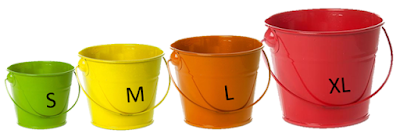agile, scrum, team leading, coaching, training, project management
Monday, 15 May 2017
Agile games: estimation
Recently in Bulgarian Agile Community meetup we discussed some games and techniques used in Agile, related to estimating. In this post you will find three of them, related to estimation:
I. Estimation buckets
It is a way to do estimation of large numbers of items with a group of people quickly (a good alternative of Planning Poker). It also provides a way to establish initial ‘reference value’ to story points when new teams need to.
1. The product backlog items have to be written on cards. It is preferable if the team members are familiar with the items. A table or wall is setup with columns as per the example
If you do not have a reference for story points just leave the numbers blank and add them in the end.
2. Pick a random item, read it and put it in the middle bucket (under ‘8’). It is to be used as a reference.
3. Pick another item, read it, discuss it with the group, estimate it relatively to the first item and put it left (smaller) or right of it (bigger).
4. Choose another item, read, discuss, estimate relatively and place it in the appropriate bucket.
Note: If it is clear that the items scale towards only one of the sides adjust them accordingly. If the first item is smaller – scale all the items towards left (‘1’), or if bigger – scale towards right (‘100’).
5. Continue until most of the buckets have at least one reference item, and the team members get used to the relative estimation feeling and doing.
6. If there are still too many PBIs, divide them across the team members and let everyone silently (without any discussions) place accordingly.
7. Everyone in the group reviews all the items and if there is a need for correction, items are taken out, discussed with the group and placed back accordingly.
8. Write the corresponding number to each card to record the estimates.
The final result would be something like
II. Estimation game (sort of)
This we do together with some of the agile teams in Continental AG. The purpose is to foresee how many and which items will go to the next sprint backlog. It is useful when there not all team members have the expertise to do each PBI. The sprint is set to three weeks’ timeframe.
1. The PBIs are written on cards or tracked in JIRA and the team members are familiar with them.
2. We take the top ten PBIs and put them into four main categories: small; medium; large; huge.
Small – item could be finished up to a week.
Medium – item could be finished up to two weeks.
Large – item could be finished up to three weeks.
Huge – item is estimated to need more than three weeks for completion.
3. Items marked ‘small-large’ fit into one sprint. Items marked ‘huge’ need to be broken down / renegotiated.
4. Then we do some ‘typical resourcing’ as not each team member have the expertise to work on each of the PBIs. For example John and George will work on item one. Steve is the only one able to complete item two. Nick takes item three, etc… The resourcing is done according the prioritization in the product backlog so it is clear which stories could go into the next sprint.
5. Sometimes it’s not possible to take all highest priority items and the product owner is triggered to choose between 'competing items'.
6. In the end the team comes with a proposal how many PBIs and which ones could fit into the next sprint, as per the example (the green dots):
7. The product owner agrees or renegotiates the items, together with the team.
III. Project box experiment
The purpose of the ‘project box’ is to define requirements for an MVP. It could be used when a large number of stakeholders (e.g. in different departments) need to provide requirements and priorities for a product.
1. Provide each department/stakeholder group with equal amount of ‘fake currency’ or vote points.
2. Let each group define and visualize their idea in a form of a product with characteristics.
3. Individuals from each group to present to all the other groups the vision of the product (MVP) in just 3 minutes.
4. The other groups have to spend their ‘money’ or vote points on each presented MVP.
5. The most ‘expensive / voted’ MVP wins and is a candidate for production or further discussion / refinement.
---
Hope those are useful to you, guys; as usual please leave your feedback in the comments.
Subscribe to:
Post Comments (Atom)




Quite useful. Love the 'project box' idea
ReplyDelete